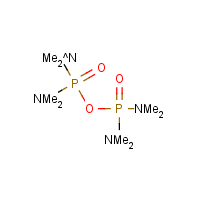Schradan
Agent Name
Schradan
CAS Number
152-16-9
Formula
C8-H24-N4-O3-P2
Major Category
Pesticides

Synonyms
Octamethyl pyrophosphoramide; Bis(bisdimethylaminophosphonous) anhydride; Bis(bisdimethylaminophosphonous)anhydride; Bis(dimethylamino)phosphonous anhydride; Bis(dimethylamino)phosphoric anhydride; Bis-N,N,N',N'-tetramethylphosphorodiamidic anhydride; Diphosphoramide, octamethyl-; ENT 17,291; Lethalaire G-59; OMPA; Octamethyl; Octamethyl pyrophosphortetramide; Octamethyl tetramido pyrophosphate; Octamethyl-difosforzuur-tetramide [Dutch]; Octamethyl-diphosphorsaeure-tetramid [German]; Octamethyldiphosphoramide; Octamethylpyrophosphoramide; Octamethylpyrophosphoric acid amide; Octamethylpyrophosphoric acid tetramide; Octamidophos; Oktamethyl [Czech]; Oktamidofos [Czech]; Ompacide; Ompatox; Ompax; Ottometil-pirofosforammide [Italian]; Pestox; Pestox 3; Pestox 66; Pestox III; Pyrophosphoramide, octamethyl-; Pyrophosphoric acid octamethyltetraamide; Pyrophosphoryltetrakisdimethylamide; Schradan [ISO]; Schradane [French]; Systam; Systophos; Sytam; Tetrakisdimethylaminophosphonous anhydride; [ChemIDplus] UN3018
Category
Organophosphate Insecticides
Description
Liquid; mp = 14-20 deg C; [Merck Index] Dark brown liquid; mp = 14-20 deg C; [CAMEO]
Sources/Uses
Used as acaricide, systemic insecticide, and soil drench for transplanted trees; Absorbed by plants for long term insect and arachnid protection; No known current use; [HSDB]
Comments
Decrease in growth and whole blood cholinesterase activity were observed in one year feeding study with rats; No adverse histopathology or effects to brain activity were observed; Inhibits brain cholinesterase in animals far less than that in the blood; [HSDB] Highly toxic cholinesterase inhibitor; [CAMEO] “The average of two baseline respective cholinesterase activity determinations three days apart, with no exposures to enzyme inhibiting pesticides for at least 30 days, is recommended for each worker prior to exposure to cholinesterase inhibitors because of large inter-individual differences in published baseline values. To be established at least once a year. Removal from workplace exposures is recommended until the cholinesterase activity returns to within 20% of baseline.” [TLVs and BEIs]
Restricted
Not registered with the EPA for use as pesticide in the US; [CAMEO]
Biomedical References
Exposure Assessment
BEI
Acetylcholinesterase activity in red blood cells = 70% of individual's baseline; Butylcholinesterase activity in serum or plasma = 60% of individual's baseline; Sample at end of shift; [TLVs and BEIs]
Vapor Pressure
0.001 mm Hg
Lethal Concentration
LCLo (rat) = 8 mg/m3/4h
Explanatory Notes
The Guide in the Emergency Response Guidebook is for "Organophosphorus pesticide, liquid, toxic."
Adverse Effects
Other Poison
Organophosphate
Diseases, Processes, and Activities Linked to This Agent
Diseases
Occupational diseases associated with exposure to this agent:
Processes
Industrial Processes with risk of exposure: